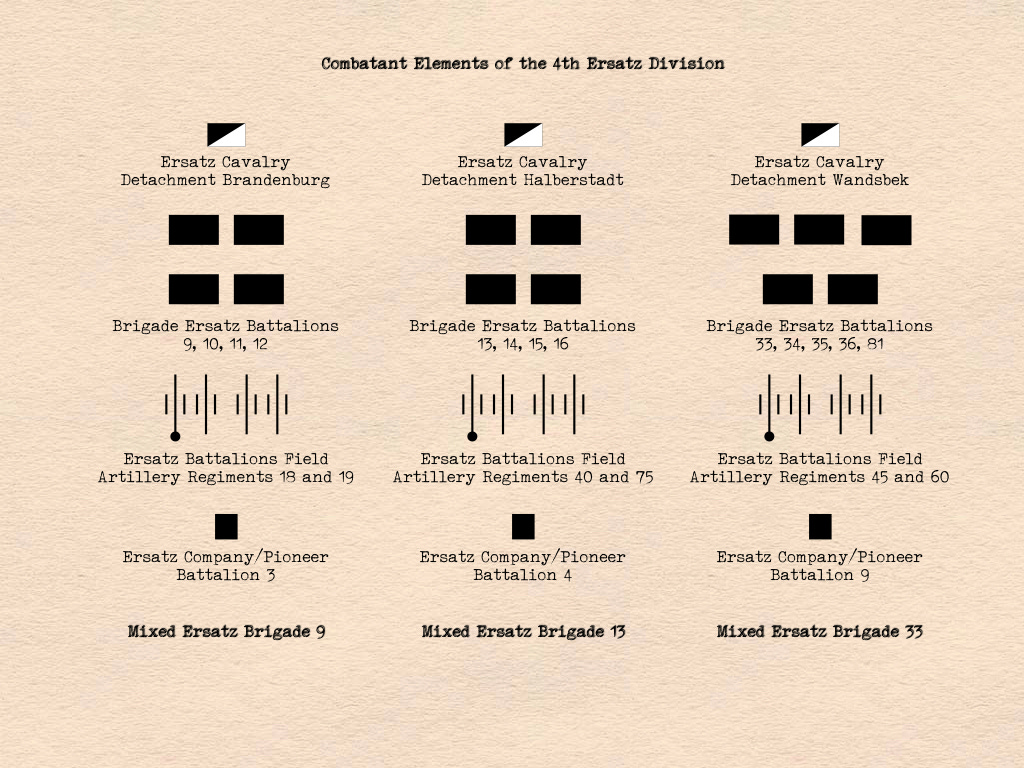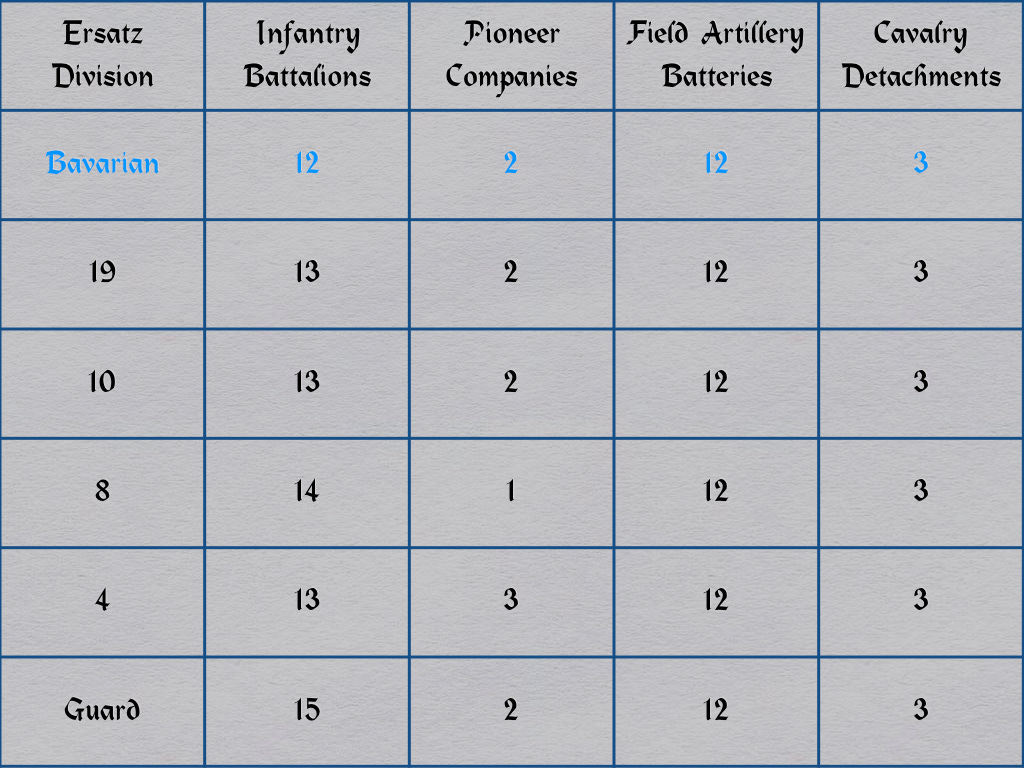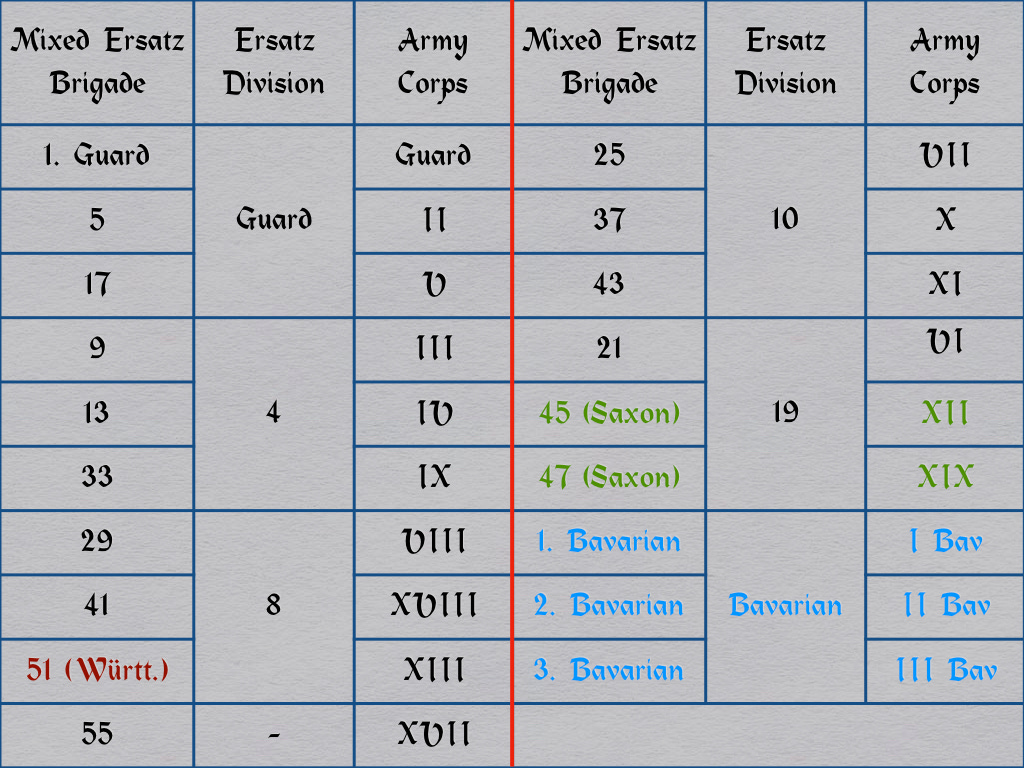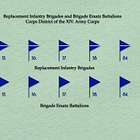Ersatz Divisions
German Infantry Divisions (1914-1915)
The structure of the mixed Ersatz brigades raised in August of 1914 had more to do with the mechanics of mobilization than any particular concept of employment. This, while they were combined arms formations in their own right, most mixed Ersatz brigades were quickly formed into divisions. (Of the nineteen mixed Ersatz brigades formed in August of 1914, eighteen were assembled into Ersatz divisions.)1
The 1905 version of the Schlieffen Plan assumed the mobilization of eight Ersatz divisions. Of these, two would lay siege to Nancy while six would bottle up the French garrison of Paris while the “right wing” swung past that city. In August of 1914, however, only six Ersatz divisions were raised. (These were the Guard Ersatz Division and Bavarian Ersatz Division, as well a the 4th, 8th, 10th, and 19th Ersatz Divisions.)
Five of the six Ersatz divisions ended up fighting in Alsace-Lorraine, on the “left wing” of the initial deployment of the German field armies in the west. The Guard Ersatz Division fought in the general area of Verdun (at what might be called the “hinge” of the two wings.)
The structure of mixed Ersatz brigades made them easy to combine into divisions. Three mixed Ersatz brigades provided twelve or more infantry battalions and twelve field artillery batteries. The resulting formation thus possessed as much (if not more) in the way of infantry as any other German infantry division of the time, as much field artillery as the most favored of its counterparts, and twice the field artillery of most Reserve divisions.
Where pioneer companies were concerned, Ersatz divisions also compared favorably with other sorts of divisions mobilized at the start of the war. At a time when the half of all active and Reserve divisions made do with a single pioneer company, only one Ersatz division was in that unhappy position. To put things another way, while each active or Reserve division enjoyed, on average, the services of 1.5 pioneer companies, the average ratio of divisional pioneer companies to Ersatz divisions was 2.0.
The units that made up each Ersatz division came from two or three army corps areas [Korpsbereiche]. Thus, in order to prevent the administrative confusion that might result from the creation of regiments connected to two different districts, there was no attempt to form the battalions, batteries, and squadrons of Ersatz divisions into regiments. Instead, the mixed Ersatz brigades of Ersatz divisions retained their character as distinct formations for much of the first year of the war.
The retention of the distinctive structure of mixed Ersatz brigades resulted in considerable variation in the number of infantry battalions serving with each Ersatz division. The same was true of pioneer companies, which were provided to some, but not all, of the mixed Ersatz brigades. At the same time, as the allocation of field artillery and cavalry detachments to mixed Ersatz brigades was uniform, each Ersatz division possessed the same number of field batteries and cavalry detachments.
This mixture of variance and regularity stemmed from the way that mixed Ersatz brigades were formed. In those nineteen army corps areas that formed mixed Ersatz brigades, each infantry brigade district formed a single Ersatz infantry battalion. (This is why the infantry battalions bore the confusing moniker of Brigade Ersatz Bataillon.) In an ideal army corps area, this yielded four Ersatz infantry battalions. In army corps areas with a fifth infantry brigade district, the result was a mixed Ersatz brigade with five infantry battalions.2
The provision of pioneer companies to mixed Ersatz battalions was even more complicated than the allocation of infantry battalions. In time of peace, fifteen of the twenty-five army corps of the German Empire possessed a single pioneer battalion while ten army corps provided a home to two such units. Of these thirty-five pioneer battalions, moreover, most were older units that, as a result of their antiquity, were well supplied with reservists. A few, however, were newer units that had not been around long enough to produce a sufficient number of “graduates” to fill all gaps in their ranks upon mobilization.
As a result of this situation, twelve of the nineteen army corps areas that raised mixed Ersatz brigades were in a position to form an Ersatz pioneer company. Seven, however, were not. When the mixed Ersatz brigades were formed into Ersatz divisions, there was one case where three brigades that possessed pioneer companies came together, thereby forming a division with three pioneer companies. Likewise, there was one division where only one of three founding brigades had received a pioneer company. In the other four instances, two out of three Ersatz brigades in each Ersatz division brought a pioneer company to the party.
The shortage of reservists was even more pronounced in depots of cavalry regiments than it was with pioneer battalions. Thus, each corps area, each of which possessed four, six, or eight cavalry depots, could only find enough reservists to fill an Ersatz cavalry detachment [Kavallerie Ersatz Abteilung] of sixty or so horse soldiers. However, the fact that there were so many depots in each corps district ensured that the provision of reservists was relatively even.
The fact that each cavalry detachment bore the name of the city in which it was assembled, rather than the name of a peacetime cavalry unit, reminded all concerned of its broad-based provenance. Similarly, the fact that each of the Ersatz cavalry detachments was known as a “cavalry detachment,” rather than a detachment of uhlans, hussars, or dragoons, provided a second reminder of that way that such units had been raised.
The uniformity of the field artillery detachments of each mixed Ersatz brigade, and thus the field artillery establishments of each Ersatz division, reflected the remarkably regular structure of the field artillery of the German Empire as a whole. This, in turn, resulted from the thoroughgoing reform that, in the years between 1898 and 1900, provided each peacetime army corps with four field artillery regiments, each of which was built upon a common framework. (When, in the years between 1900 and 1912, new army corps were formed, the new formations were likewise provided with four field artillery regiments.)
Within the army corps that raised mixed Ersatz brigades, the depot of each peacetime artillery regiment provided the means to form a single Ersatz field artillery battery. These were then paired off to form two-battery battalions [Feldartillerie Ersatz Abteilungen].
Each of these small field artillery battalions bore the name of the depot that provided one of its batteries. Thus, for example, the four field artillery depots of the III Army Corps Area, those of the 3rd, 18th, 39th, and 54th Field Artillery Regiments, raised Feldartillerie Ersatz Abteilung 18 and Feldartillerie Ersatz Abteilung 39.
Source: The information presented in this post was derived largely from the organizational appendix [Anlage 1: Kriegsgliederungen] to the first volume [Die Grenzschlachten im Westen] of the German official history of the First World War [Der Weltkrieg: Die Operationen zu Lande, 1914-1918]; the section on the German Empire of the last prewar issue (that of 1913) of the indispensable annual Löbellsjahresberichte; and the catalogue of regimental histories [Heeres- und Truppengeschichte des Deutschen Reiches und seiner Länder: 1806 bis 1918] compiled by Eike Mohr.
For Further Reading:
The one mixed Ersatz brigade that went to war as an independent formation was the 55. gemischte Ersatz-Brigade.
The Guard Corps, which was recruited from the entirety of the Kingdom of Prussia, had neither an army corps area nor infantry brigade districts. It did, however, leave behind a considerable number of depots that, in the early days of mobilization, raised six infantry battalions for the Guard Ersatz Brigade.







Lovely!
One question regarding the graphic.
Shouldn't each brigade only have one Howitzer Battery?